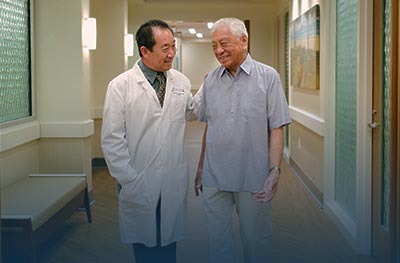Setting New Standards in Men's Cancer Care
Dr. Charles Kim is never really satisfied with what many would consider standard practice. He challenges himself to find a better path. Dr. Kim has embraced advances in medicine from the very beginning of his career. He started raising the bar right out of medical school.
“When I finished my residency, laparoscopy was just coming out,” Dr. Kim said. “I was kind of trained in that, but when I started working nobody was doing it in Hawaii or knew how to do it. So, I started doing the procedure here.”
Laparoscopic surgery is performed in the abdomen or pelvis through small incisions with the aid of a small camera. Before doing the procedure, Dr. Kim created a makeshift surgical suite in his garage. He and a fellow physician friend created a manikin of sorts and started practicing mock minimally invasive procedures. “We got old surgical instruments and then we got a video recorder and we recorded inside the dummy,” Dr. Kim said. “We poked holes in the canvas and then we did the surgery watching it on an old TV set. We practiced doing prostatectomies and we did it for months.” They’d meet at six in the morning and kept at it for hours.
A few years later, Dr. Kim soon became one of the leading laparoscopic surgeons in Hawaii in what he now refers to as being in the “right place at the right time.” In 2006, he took on robotic surgery by taking classes across the country to become just as proficient in the latest minimally invasive surgery. Dr. Kim would then assume the role of medical director of robotic surgery at Pali Momi Medical Center which is how he met Stan Kum.
Even before meeting Dr. Kim, Stan was certain the respected surgeon would be the one to remove a cancerous tumor on his kidney. After his diagnosis, a trusted doctor referred him. “He called me in and said ‘If you were my grandfather, I would tell you the same thing. I suggest you have surgery and have Dr. Kim take it [the tumor] out. He’s very good.’”
A face-to-face meeting only confirmed Stan’s faith in Dr. Kim’s abilities. Dr. Kim shared a video with Stan to show him exactly what the surgery would entail, step-by-step. The 87-year-old has now been cancer free for three years since that robotic surgery which he describes as “impressive.”
“You can’t even see the scar,” Stan said. “It was only two small incisions, it was like nothing. Usually after surgery there is a pain level you have to go through for a week or two, but with robotics there was no effect. I had no pain. I was surprised.”
Results like Stan’s are part of Dr. Kim’s vision for this program and cancer care at Pali Momi. “We wanted to do high-quality evidence-based medicine and we started with oncology,” Dr. Kim said. “The first thing we did was start the robotic program. As a result, our outcomes were very good and in 2017 we were in the top 5 percent nationally for the fewest complications.”
Robotics was just the first new technology brought to men’s cancer patients in Central and West O‘ahu. Next was a specialized 3T MRI which incorporates a technology called multiparametrics, which identifies potential cancerous tumors. Pali Momi also became the first and only program in the state to offer the UroNav Fusion Biopsy System for prostate screening.
This advanced UroNav technology combines a pre-biopsy MRI image with an ultrasound biopsy in real time, allowing physicians to target suspicious lesions more precisely and capture accurate tissue samples. “Using this technique has improved our detection of prostate cancer from 20 percent to about 70 percent,” Dr. Kim said. “So, the number of unnecessary prostate biopsies has decreased.” Another benefit of this type of testing is that the MRI fusion biopsies are meant to only detect high-grade significant cancer, not the slow-growing indolent type of prostate cancer which allows doctors to more accurately plan treatment.
Now genetic testing is allowing doctors to detect and categorize prostate cancer even earlier. “We’re kind of on the forefront on that in Hawaii,” Dr. Kim said. “We actually did a bit of research on some of the biomarkers and the cost, which actually got published. In our study we showed that we could save up to a million dollars a year.” Genomics leads to cost savings in the form of blood tests, 4K and PCA3, that offer better screening to reveal fast or slow growing cancers and whether cancer treatment is needed or not.
All of these options are just some of the advantages of the new Pali Momi Cancer Center’s comprehensive care for patients. And while Dr. Kim is helping lead the charge in adding more options for detecting and treating cancer, he is confident in this progression because of the multi-disciplinary team approach that Pali Momi utilizes. “It all kind of fits together because of the Cancer Center,” Dr. Kim said. “Usually one patient has to see the urologist, radiologist, oncologist and he sees everyone separately to get their advice. Often it gets confusing. Our multidisciplinary approach brings all of the medical specialists together as a group to talk about the patient’s best treatment plan.”
Every step forward reminds Dr. Kim how far cancer care has come since his MacGyver-style surgical setup during his humble beginnings in his garage. And after 21 years of practice, he has no plans to stop pushing to improve care and educate patients.. “We have to get the word out on men’s health. A lot of what we are doing now for prostate cancer has been done for years for breast cancer.



